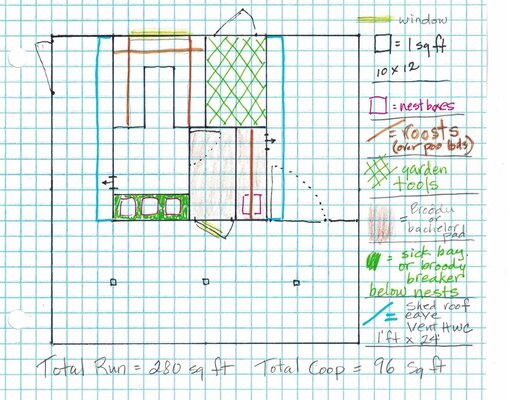Hermits Garden
Vintage American Featherless Biped
- Oct 8, 2018
- 417
- 1,801
- 296
Some details:
We live at 7100 ft elevation in eastern Arizona. The land is mostly pine and oak, no grass, lots of predators, so no free-ranging. The run will be 6' high chain link kennel panels, with 1" hardware cloth apron and 1"x2" welded wire cover.
I aim to keep 10 to 12 LF chickens--either breeding or brooding replacements for retirees, depending on how rooster-friendly future neighbors are. The coop will be a shed roof, 10 x 12 wooden structure, sharing space with separate section for garden tools. 12' x 1' eaves will remain open, covered with hardware cloth for ventilation, but with fascia boards to keep out rain and snow.
Roof pitch will be 4:12, with a gutter on the low side to take water/snow melt to storage. We'll have electric to the coop for Momma Heating Pad brooder and lights, and a frost-free standpipe close to the run gate.
I made a key to the side, but if anyone has a question, opinion, or suggestion, I'd welcome it. We haven't started yet, so if I need to make a change, now's the time.
We live at 7100 ft elevation in eastern Arizona. The land is mostly pine and oak, no grass, lots of predators, so no free-ranging. The run will be 6' high chain link kennel panels, with 1" hardware cloth apron and 1"x2" welded wire cover.
I aim to keep 10 to 12 LF chickens--either breeding or brooding replacements for retirees, depending on how rooster-friendly future neighbors are. The coop will be a shed roof, 10 x 12 wooden structure, sharing space with separate section for garden tools. 12' x 1' eaves will remain open, covered with hardware cloth for ventilation, but with fascia boards to keep out rain and snow.
Roof pitch will be 4:12, with a gutter on the low side to take water/snow melt to storage. We'll have electric to the coop for Momma Heating Pad brooder and lights, and a frost-free standpipe close to the run gate.
I made a key to the side, but if anyone has a question, opinion, or suggestion, I'd welcome it. We haven't started yet, so if I need to make a change, now's the time.
Attachments
Last edited:






